Burbank Has Smaller Plan for Terminal
- Share via
BURBANK — With the new Burbank Airport terminal plan stalled, city officials are trying to renegotiate the compromise deal they agreed to last summer and are now demanding that airport officials drastically scale back the project.
The Burbank City Council has proposed a 14-gate, 250,000-square-foot terminal to replace the existing 180,000-square-foot building.
That is significantly smaller than the 330,000-square-foot terminal that city and airport negotiators agreed to in August. But city officials say a facility that size is no longer feasible, given opposition from nearby Burbank and Los Angeles residents.
“There’s a window of opportunity to resolve this dispute, but it won’t remain open for much longer,” Burbank City Councilman David Golonski said. “This is a balanced proposal that attempts to deal with the needs of various constituencies and still remain achievable.”
But members of the Burbank-Glendale-Pasadena Airport Authority accused Burbank of going back on its commitment.
“It’s just a clever way of asking for the keys to the airport,” Pasadena Commissioner Chris Holden said.
The proposal would bar construction of the new terminal unless a mandatory overnight curfew is in place. It also would allow an additional expansion--to 280,000 square feet and 16 gates--in return for strict limits on noise.
Golonski and City Manager Robert Ovrom said the proposal would allow the airport to handle 6.7 million passengers annually--up from 4.7 million currently.
But if passenger levels rose by 10% or more above current levels, the new plan would require the Airport Authority to pass any capital project or contract in excess of $100,000 by a two-thirds vote of the board.
In deference to federal officials, Burbank agreed to buy land near the airport where a Southwest Airlines jet carrying 137 passengers and five crew members careened off a runway in March and came to rest near a gas station.
The proposal would allow the airport to create a buffer zone in which it would restrict building.
The plan for the terminal downsizing and noise limits drew immediate fire from an airline industry trade group.
“If they persist with these terms as outlined, it kills the terminal project as far as we are concerned,” said Chris Leathers, director of government affairs for the Air Transport Assn.
“This is a complete violation of federal law. You can’t limit passenger capacity and implement mandatory curfews without conducting appropriate reviews.”
Under the original proposal, city and airport negotiators tried to impose a de facto curfew without the federally required noise study by simply closing the passenger terminal between 11 p.m. and 6 a.m., without technically shutting down the runways.
Federal Aviation Administration head Jane Garvey said that plan was unacceptable.
FAA spokesman Paul Turk said the agency would examine the new proposal.
Burbank’s action comes after the city and airport missed a May 24 deadline for approving a new terminal, triggering a process that could eventually result in the sale of land earmarked for the $300-million project. Adding to the urgency, the Airport Authority last week approved the hiring of land-use consultants and property appraisers for the possible sale of the terminal site.
Burbank would have until July 31 to exercise an option on part or all of an 80-acre parcel once owned by Lockheed Martin.
Airport Executive Director Dios Marrero said he would not comment on the specifics of Burbank’s new terminal proposal but said that “It represents a significant change in the terms that the two agencies agreed upon in the framework agreement.”
Marrero said the Airport Authority will meet in a special session today to “evaluate it and prepare a counterproposal.”
City leaders said in addition to scaling back the terminal, they removed or adjusted other controversial provisions, including a $1.5-million annual payment from the airport to the city in lieu of lost property tax revenue, and a proposed permanent ban on easterly takeoffs.
Glendale Airport Commissioner Jerry Briggs raised the possibility that some airport commissioners might try to relocate the new terminal to another site on the existing airport property.
“We have a responsibility to the flying public to provide a safe and convenient terminal,” Briggs said. “As a consequence, we have no other alternative but to consider a safer alternative for the terminal on airport property.”
But attorney Peter Kirsch, special counsel for Burbank on airport issues, pointed out that any new terminal project would require Burbank city approval.
“That’s state law,” he said.
“The residents asked the city to be sure it could justify a terminal of 330,000 square feet,” Kirsch said.
“We hired consultants who advised us that the terminal in the framework was larger than necessary to handle the anticipated traffic.”
Since 1980, the airport has been trying to update the existing 1930s-era facility, which federal officials maintain is too close to the runway under modern safety standards.
After a protracted and bitter fight, city and airport negotiators signed a tentative deal in August to build a new terminal and settle litigation between the parties.
But the plan came under attack from residents, airlines, FAA and others.
To assuage Burbank residents, the City Council agreed to get voter approval on any terminal plan.
“It’s a fair and reasonable offer from the city,” Charles Lombardo, one of the three commissioners from Burbank on the nine-member Airport Authority, said of the latest plan. “If this isn’t accepted, we won’t see a new terminal for the foreseeable future.”
(BEGIN TEXT OF INFOBOX / INFOGRAPHIC)
Dates in Burbank Airport Terminal Battle
Aug. 3, 1999--Negotiators for the city of Burbank and the Airport Authority sign “Framework for Settlement,” agreeing to build a 14-gate terminal, with later expansion to 19 gates. The proposal includes a “de facto” curfew that would shutter the terminal building overnight and ban easterly takeoffs.
Aug. 8--The airline industry’s trade group--the Air Transport Assn.--publicly questions if the terminal plan is a backdoor curfew and whether it can be imposed without Federal Aviation Administration approval.
Sept. 23--The FAA expresses serious concerns with a plan to build a 14-gate terminal at Burbank Airport, further clouding a deal that already faces intense criticism from local residents, politicians and aviation groups.
Sept. 29--Los Angeles City Atty. James K. Hahn threatens to file suit to block Burbank Airport’s proposed 14-gate terminal unless officials agree to conduct a new environmental study.
Jan. 2, 2000--FAA chief Jane Garvey says in a letter to The Times that a proposed ban on easterly takeoffs at Burbank Airport should be removed from the draft agreement for a new airport terminal and that “all relevant parties” should be brought to the table.
Feb. 4--Charging that federal officials had caved in to the airlines and abandoned a “local solution” to the expansion of Burbank Airport, Burbank Mayor Stacey Murphy says that the city would suspend work on a development agreement for a new terminal.
March 14--”Restore Our Airport Rights,” a group of Burbank residents opposed to airport expansion, says it has gathered 7,400 signatures, enough to qualify for a municipal ballot an initiative to limit the size of the Burbank Airport terminal.
March 15--Burbank officials disqualify a petition that could have stalled construction of a new $300-million Burbank Airport terminal, saying that the document failed to meet state requirements for ballot initiatives.
March 28--The Burbank City Council unanimously agrees to have voters approve any new airport terminal.
April 17--Burbank Airport officials vote to launch an exhaustive noise study that officials say could delay the terminal project for three years or more.
May 24--The deadline for approving a new Burbank Airport terminal expires, triggering a process that could end with the sale of land designated for the $300-million project.
June 20--Burbank proposes new terminal plan.
(BEGIN TEXT OF INFOBOX / INFOGRAPHIC)
Passenger projections
The latest Burbank Airport proposal is designed to haxxle 6.7 million passengers annually, while the annual traffic has hovered below 5 million for the last five years.
*
Source: City of Burbank
More to Read
Sign up for Essential California
The most important California stories and recommendations in your inbox every morning.
You may occasionally receive promotional content from the Los Angeles Times.









